Financial Accounting: From Journal Entries to Balance Sheet
VerifiedAdded on 2020/02/05
|26
|5367
|167
Homework Assignment
AI Summary
This document provides a comprehensive overview of financial accounting, starting with fundamental concepts and principles. It delves into the practical aspects of accounting, including the creation of journal entries, the maintenance of ledger accounts, and the preparation of profit and loss statements and balance sheets. The assignment covers important topics such as bank reconciliation statements, suspense accounts, and control accounts. It also discusses the regulatory framework of financial accounting, including the role of the Financial Accounting Standards Board (FASB) and the application of International Accounting Standards (IAS). Furthermore, the document explains accounting rules, principles, and conventions, including going concern, materiality, and consistency. The document includes examples of ledger accounts for different transactions, such as sales, purchases, and expenses. Desklib offers this assignment to aid students in understanding financial accounting.
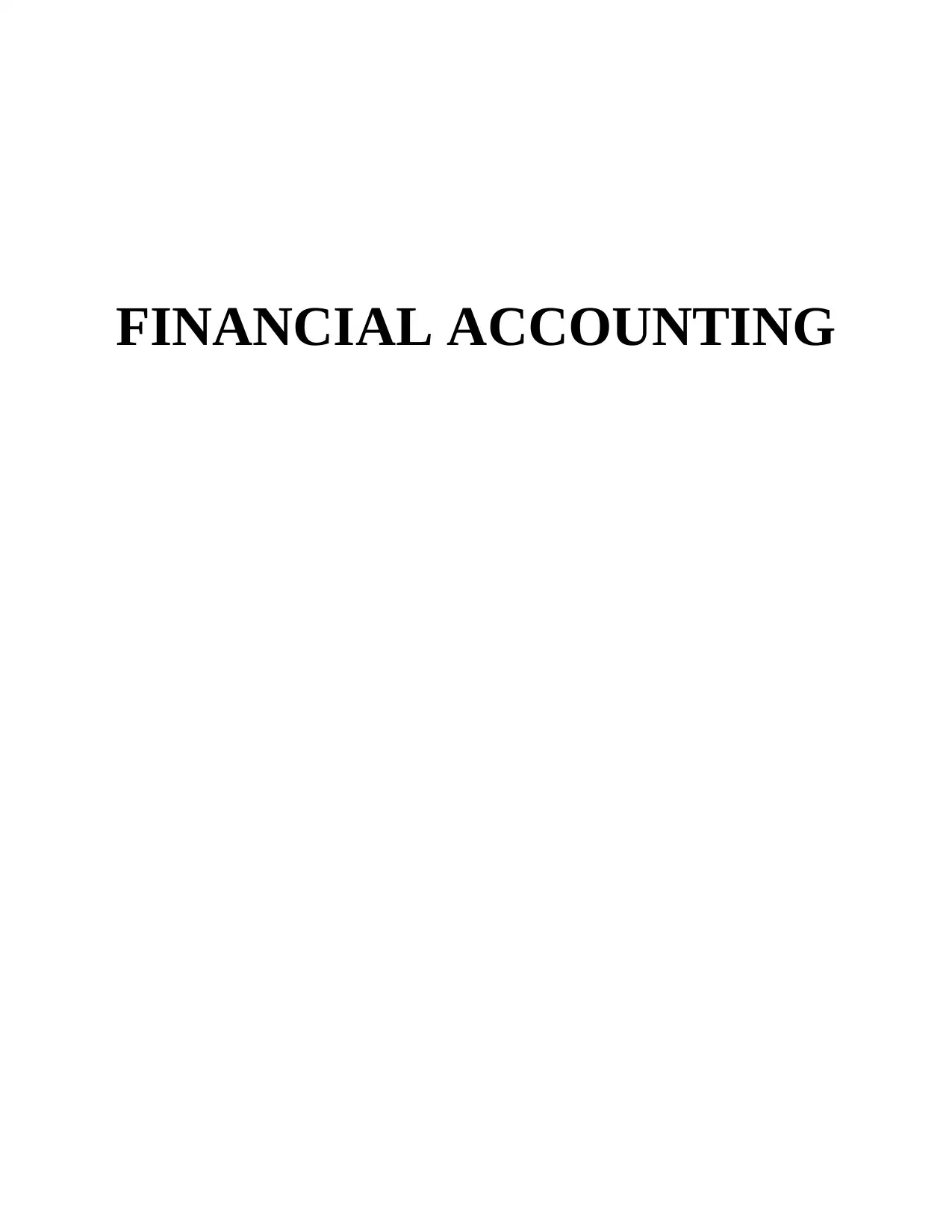
FINANCIAL ACCOUNTING
Paraphrase This Document
Need a fresh take? Get an instant paraphrase of this document with our AI Paraphraser
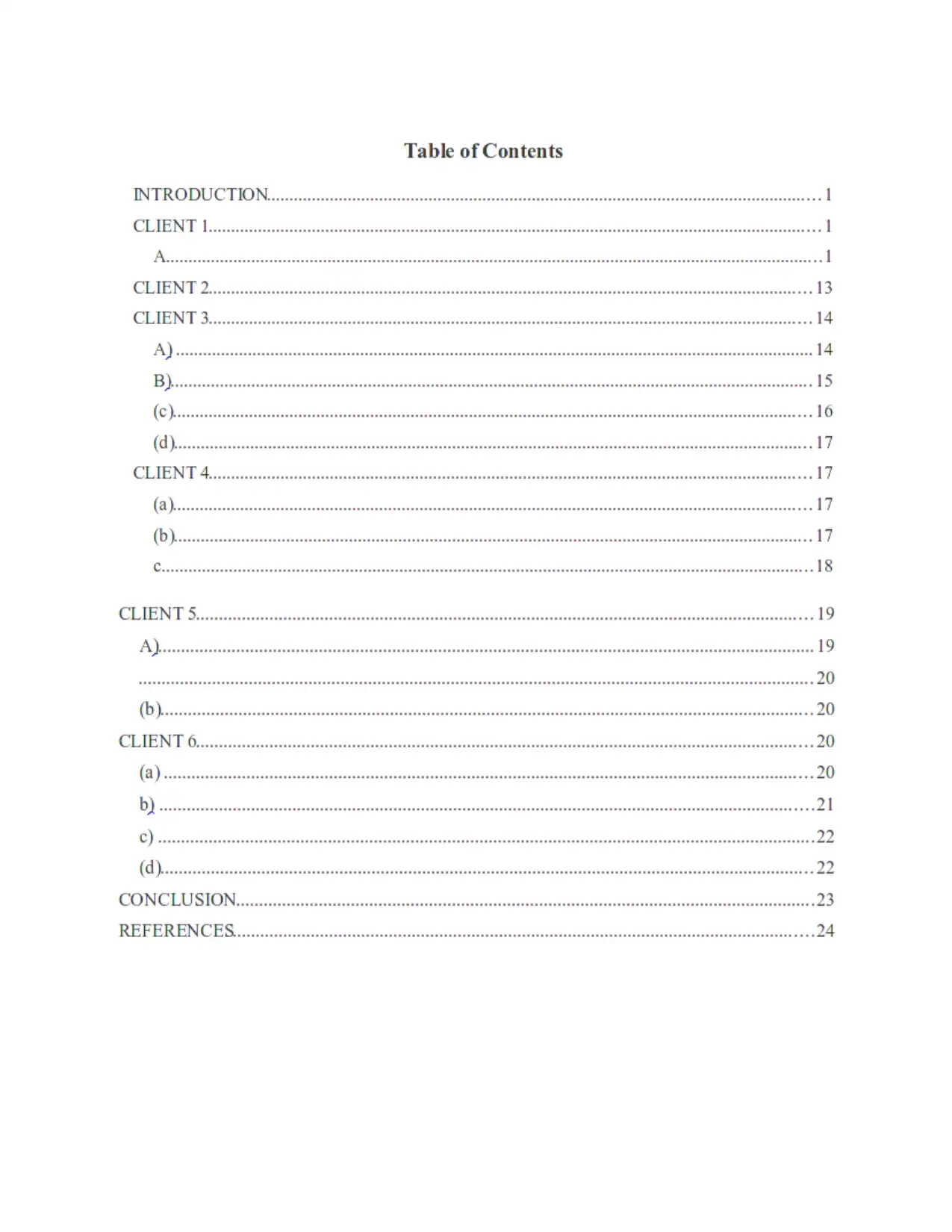
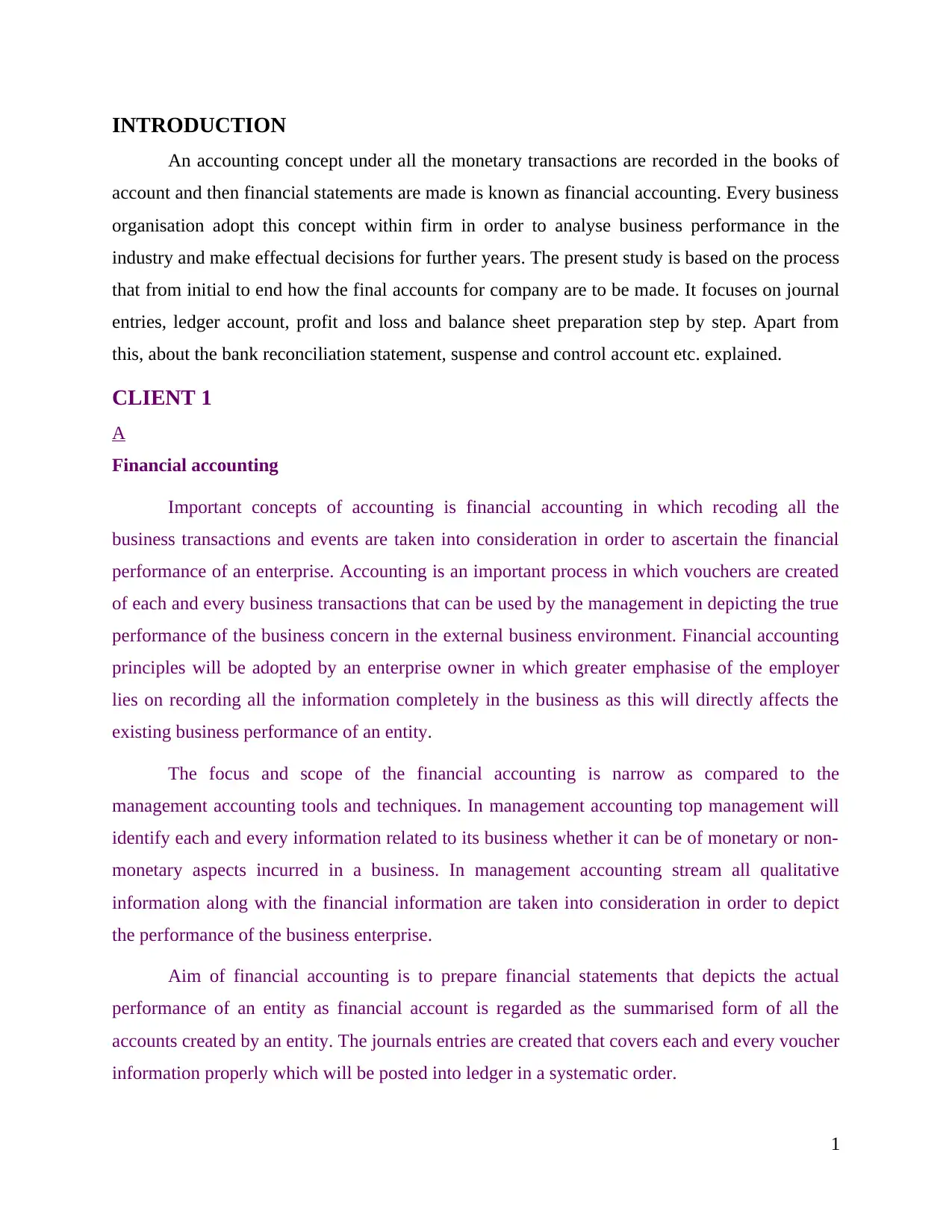
INTRODUCTION
An accounting concept under all the monetary transactions are recorded in the books of
account and then financial statements are made is known as financial accounting. Every business
organisation adopt this concept within firm in order to analyse business performance in the
industry and make effectual decisions for further years. The present study is based on the process
that from initial to end how the final accounts for company are to be made. It focuses on journal
entries, ledger account, profit and loss and balance sheet preparation step by step. Apart from
this, about the bank reconciliation statement, suspense and control account etc. explained.
CLIENT 1
A
Financial accounting
Important concepts of accounting is financial accounting in which recoding all the
business transactions and events are taken into consideration in order to ascertain the financial
performance of an enterprise. Accounting is an important process in which vouchers are created
of each and every business transactions that can be used by the management in depicting the true
performance of the business concern in the external business environment. Financial accounting
principles will be adopted by an enterprise owner in which greater emphasise of the employer
lies on recording all the information completely in the business as this will directly affects the
existing business performance of an entity.
The focus and scope of the financial accounting is narrow as compared to the
management accounting tools and techniques. In management accounting top management will
identify each and every information related to its business whether it can be of monetary or non-
monetary aspects incurred in a business. In management accounting stream all qualitative
information along with the financial information are taken into consideration in order to depict
the performance of the business enterprise.
Aim of financial accounting is to prepare financial statements that depicts the actual
performance of an entity as financial account is regarded as the summarised form of all the
accounts created by an entity. The journals entries are created that covers each and every voucher
information properly which will be posted into ledger in a systematic order.
1
An accounting concept under all the monetary transactions are recorded in the books of
account and then financial statements are made is known as financial accounting. Every business
organisation adopt this concept within firm in order to analyse business performance in the
industry and make effectual decisions for further years. The present study is based on the process
that from initial to end how the final accounts for company are to be made. It focuses on journal
entries, ledger account, profit and loss and balance sheet preparation step by step. Apart from
this, about the bank reconciliation statement, suspense and control account etc. explained.
CLIENT 1
A
Financial accounting
Important concepts of accounting is financial accounting in which recoding all the
business transactions and events are taken into consideration in order to ascertain the financial
performance of an enterprise. Accounting is an important process in which vouchers are created
of each and every business transactions that can be used by the management in depicting the true
performance of the business concern in the external business environment. Financial accounting
principles will be adopted by an enterprise owner in which greater emphasise of the employer
lies on recording all the information completely in the business as this will directly affects the
existing business performance of an entity.
The focus and scope of the financial accounting is narrow as compared to the
management accounting tools and techniques. In management accounting top management will
identify each and every information related to its business whether it can be of monetary or non-
monetary aspects incurred in a business. In management accounting stream all qualitative
information along with the financial information are taken into consideration in order to depict
the performance of the business enterprise.
Aim of financial accounting is to prepare financial statements that depicts the actual
performance of an entity as financial account is regarded as the summarised form of all the
accounts created by an entity. The journals entries are created that covers each and every voucher
information properly which will be posted into ledger in a systematic order.
1
⊘ This is a preview!⊘
Do you want full access?
Subscribe today to unlock all pages.

Trusted by 1+ million students worldwide
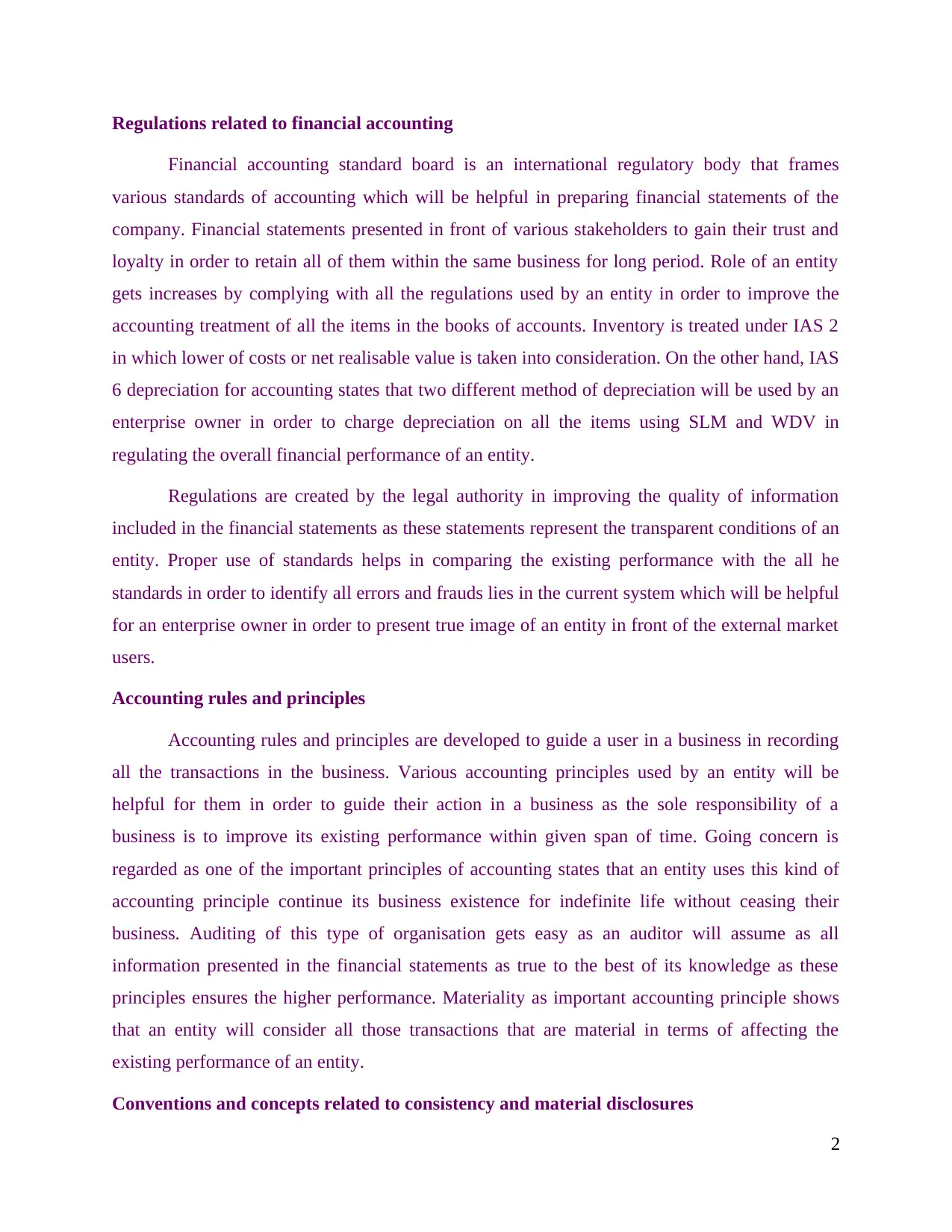
Regulations related to financial accounting
Financial accounting standard board is an international regulatory body that frames
various standards of accounting which will be helpful in preparing financial statements of the
company. Financial statements presented in front of various stakeholders to gain their trust and
loyalty in order to retain all of them within the same business for long period. Role of an entity
gets increases by complying with all the regulations used by an entity in order to improve the
accounting treatment of all the items in the books of accounts. Inventory is treated under IAS 2
in which lower of costs or net realisable value is taken into consideration. On the other hand, IAS
6 depreciation for accounting states that two different method of depreciation will be used by an
enterprise owner in order to charge depreciation on all the items using SLM and WDV in
regulating the overall financial performance of an entity.
Regulations are created by the legal authority in improving the quality of information
included in the financial statements as these statements represent the transparent conditions of an
entity. Proper use of standards helps in comparing the existing performance with the all he
standards in order to identify all errors and frauds lies in the current system which will be helpful
for an enterprise owner in order to present true image of an entity in front of the external market
users.
Accounting rules and principles
Accounting rules and principles are developed to guide a user in a business in recording
all the transactions in the business. Various accounting principles used by an entity will be
helpful for them in order to guide their action in a business as the sole responsibility of a
business is to improve its existing performance within given span of time. Going concern is
regarded as one of the important principles of accounting states that an entity uses this kind of
accounting principle continue its business existence for indefinite life without ceasing their
business. Auditing of this type of organisation gets easy as an auditor will assume as all
information presented in the financial statements as true to the best of its knowledge as these
principles ensures the higher performance. Materiality as important accounting principle shows
that an entity will consider all those transactions that are material in terms of affecting the
existing performance of an entity.
Conventions and concepts related to consistency and material disclosures
2
Financial accounting standard board is an international regulatory body that frames
various standards of accounting which will be helpful in preparing financial statements of the
company. Financial statements presented in front of various stakeholders to gain their trust and
loyalty in order to retain all of them within the same business for long period. Role of an entity
gets increases by complying with all the regulations used by an entity in order to improve the
accounting treatment of all the items in the books of accounts. Inventory is treated under IAS 2
in which lower of costs or net realisable value is taken into consideration. On the other hand, IAS
6 depreciation for accounting states that two different method of depreciation will be used by an
enterprise owner in order to charge depreciation on all the items using SLM and WDV in
regulating the overall financial performance of an entity.
Regulations are created by the legal authority in improving the quality of information
included in the financial statements as these statements represent the transparent conditions of an
entity. Proper use of standards helps in comparing the existing performance with the all he
standards in order to identify all errors and frauds lies in the current system which will be helpful
for an enterprise owner in order to present true image of an entity in front of the external market
users.
Accounting rules and principles
Accounting rules and principles are developed to guide a user in a business in recording
all the transactions in the business. Various accounting principles used by an entity will be
helpful for them in order to guide their action in a business as the sole responsibility of a
business is to improve its existing performance within given span of time. Going concern is
regarded as one of the important principles of accounting states that an entity uses this kind of
accounting principle continue its business existence for indefinite life without ceasing their
business. Auditing of this type of organisation gets easy as an auditor will assume as all
information presented in the financial statements as true to the best of its knowledge as these
principles ensures the higher performance. Materiality as important accounting principle shows
that an entity will consider all those transactions that are material in terms of affecting the
existing performance of an entity.
Conventions and concepts related to consistency and material disclosures
2
Paraphrase This Document
Need a fresh take? Get an instant paraphrase of this document with our AI Paraphraser
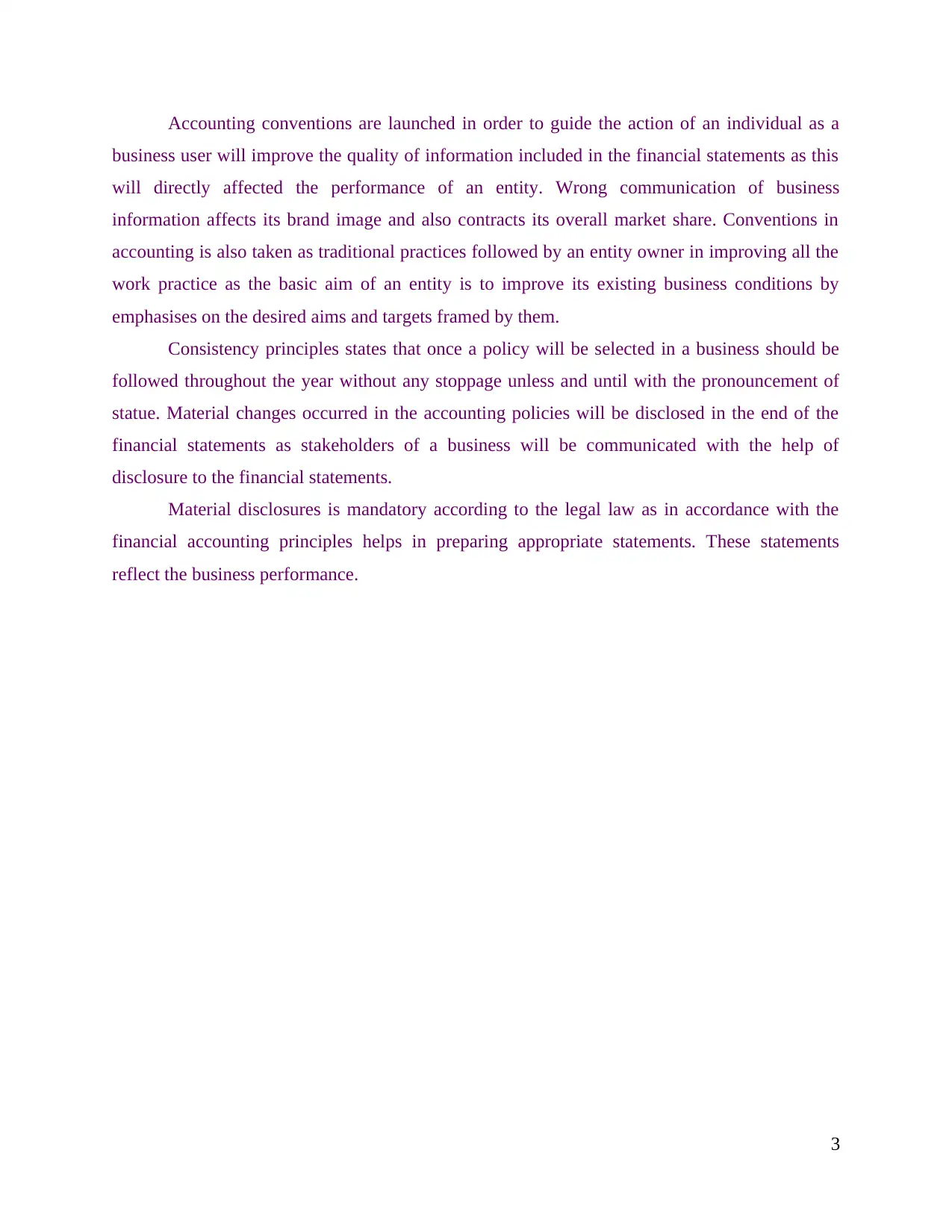
Accounting conventions are launched in order to guide the action of an individual as a
business user will improve the quality of information included in the financial statements as this
will directly affected the performance of an entity. Wrong communication of business
information affects its brand image and also contracts its overall market share. Conventions in
accounting is also taken as traditional practices followed by an entity owner in improving all the
work practice as the basic aim of an entity is to improve its existing business conditions by
emphasises on the desired aims and targets framed by them.
Consistency principles states that once a policy will be selected in a business should be
followed throughout the year without any stoppage unless and until with the pronouncement of
statue. Material changes occurred in the accounting policies will be disclosed in the end of the
financial statements as stakeholders of a business will be communicated with the help of
disclosure to the financial statements.
Material disclosures is mandatory according to the legal law as in accordance with the
financial accounting principles helps in preparing appropriate statements. These statements
reflect the business performance.
3
business user will improve the quality of information included in the financial statements as this
will directly affected the performance of an entity. Wrong communication of business
information affects its brand image and also contracts its overall market share. Conventions in
accounting is also taken as traditional practices followed by an entity owner in improving all the
work practice as the basic aim of an entity is to improve its existing business conditions by
emphasises on the desired aims and targets framed by them.
Consistency principles states that once a policy will be selected in a business should be
followed throughout the year without any stoppage unless and until with the pronouncement of
statue. Material changes occurred in the accounting policies will be disclosed in the end of the
financial statements as stakeholders of a business will be communicated with the help of
disclosure to the financial statements.
Material disclosures is mandatory according to the legal law as in accordance with the
financial accounting principles helps in preparing appropriate statements. These statements
reflect the business performance.
3
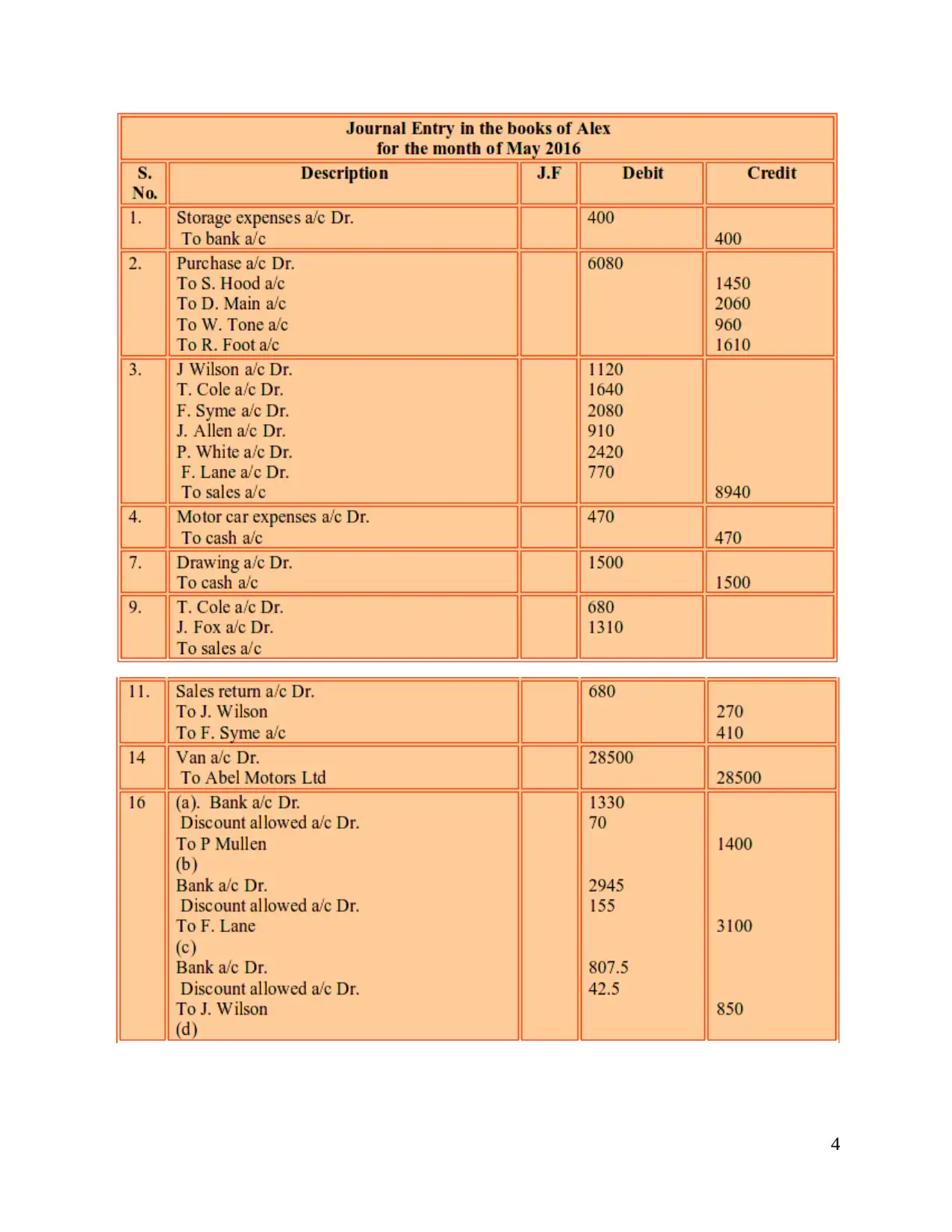
4
⊘ This is a preview!⊘
Do you want full access?
Subscribe today to unlock all pages.

Trusted by 1+ million students worldwide
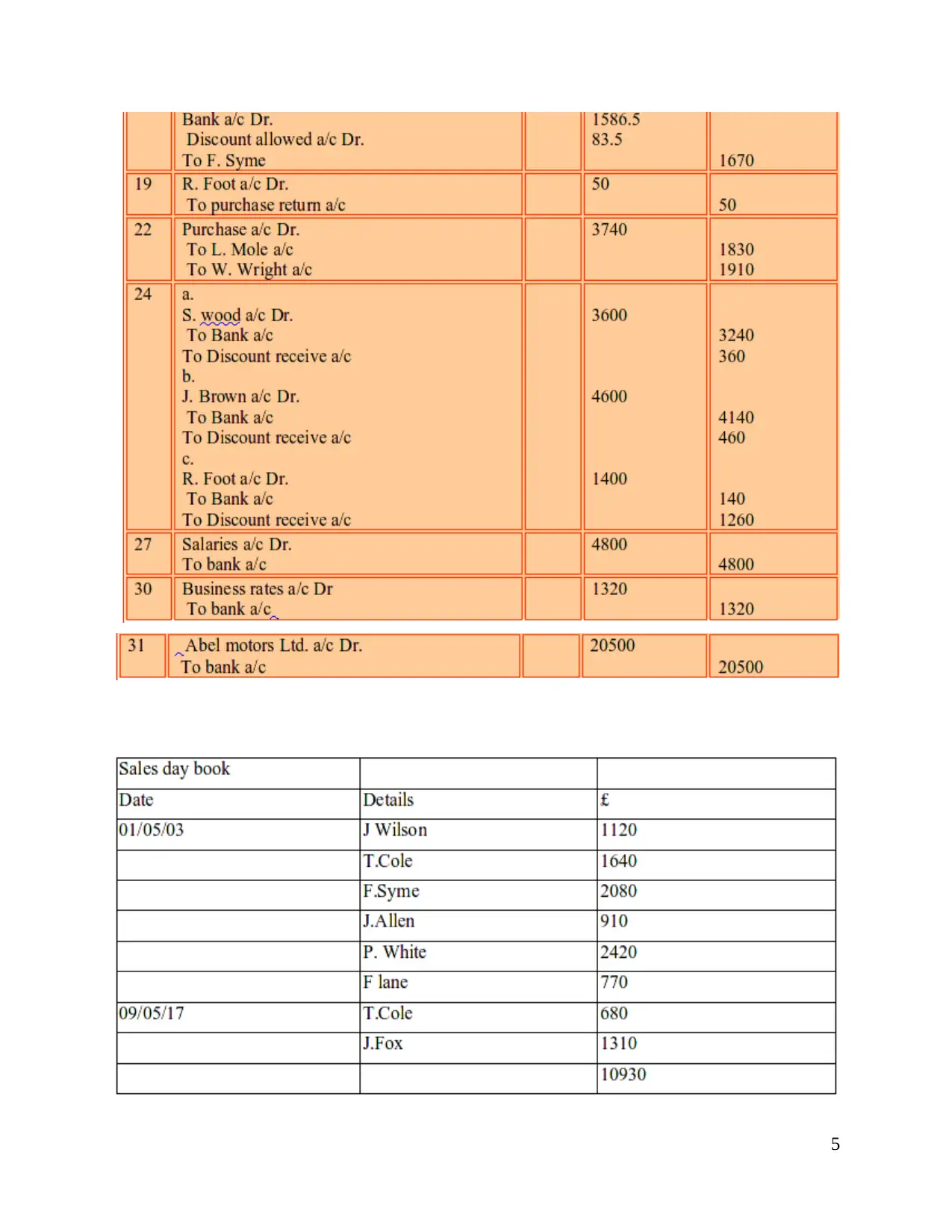
5
Paraphrase This Document
Need a fresh take? Get an instant paraphrase of this document with our AI Paraphraser
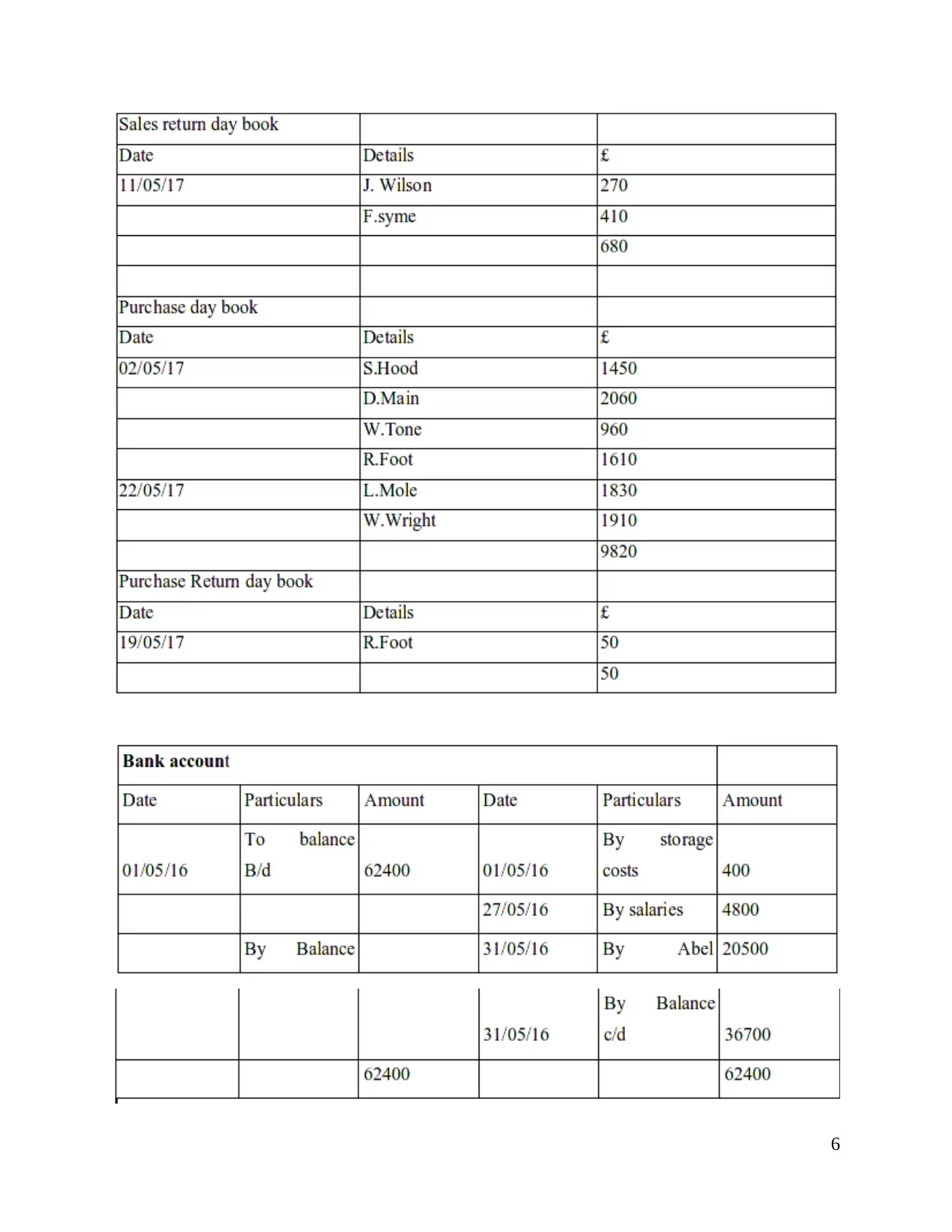
6
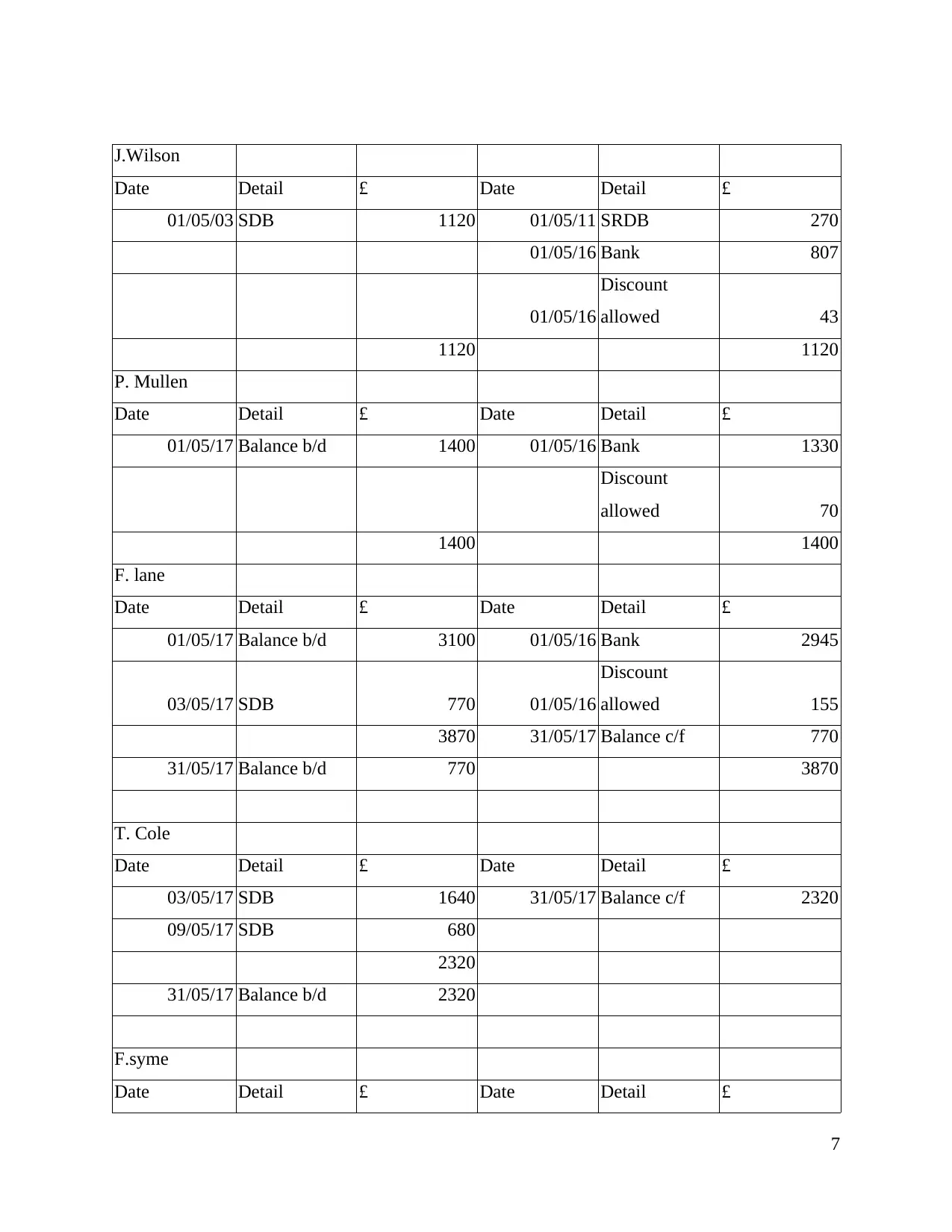
J.Wilson
Date Detail £ Date Detail £
01/05/03 SDB 1120 01/05/11 SRDB 270
01/05/16 Bank 807
01/05/16
Discount
allowed 43
1120 1120
P. Mullen
Date Detail £ Date Detail £
01/05/17 Balance b/d 1400 01/05/16 Bank 1330
Discount
allowed 70
1400 1400
F. lane
Date Detail £ Date Detail £
01/05/17 Balance b/d 3100 01/05/16 Bank 2945
03/05/17 SDB 770 01/05/16
Discount
allowed 155
3870 31/05/17 Balance c/f 770
31/05/17 Balance b/d 770 3870
T. Cole
Date Detail £ Date Detail £
03/05/17 SDB 1640 31/05/17 Balance c/f 2320
09/05/17 SDB 680
2320
31/05/17 Balance b/d 2320
F.syme
Date Detail £ Date Detail £
7
Date Detail £ Date Detail £
01/05/03 SDB 1120 01/05/11 SRDB 270
01/05/16 Bank 807
01/05/16
Discount
allowed 43
1120 1120
P. Mullen
Date Detail £ Date Detail £
01/05/17 Balance b/d 1400 01/05/16 Bank 1330
Discount
allowed 70
1400 1400
F. lane
Date Detail £ Date Detail £
01/05/17 Balance b/d 3100 01/05/16 Bank 2945
03/05/17 SDB 770 01/05/16
Discount
allowed 155
3870 31/05/17 Balance c/f 770
31/05/17 Balance b/d 770 3870
T. Cole
Date Detail £ Date Detail £
03/05/17 SDB 1640 31/05/17 Balance c/f 2320
09/05/17 SDB 680
2320
31/05/17 Balance b/d 2320
F.syme
Date Detail £ Date Detail £
7
⊘ This is a preview!⊘
Do you want full access?
Subscribe today to unlock all pages.

Trusted by 1+ million students worldwide
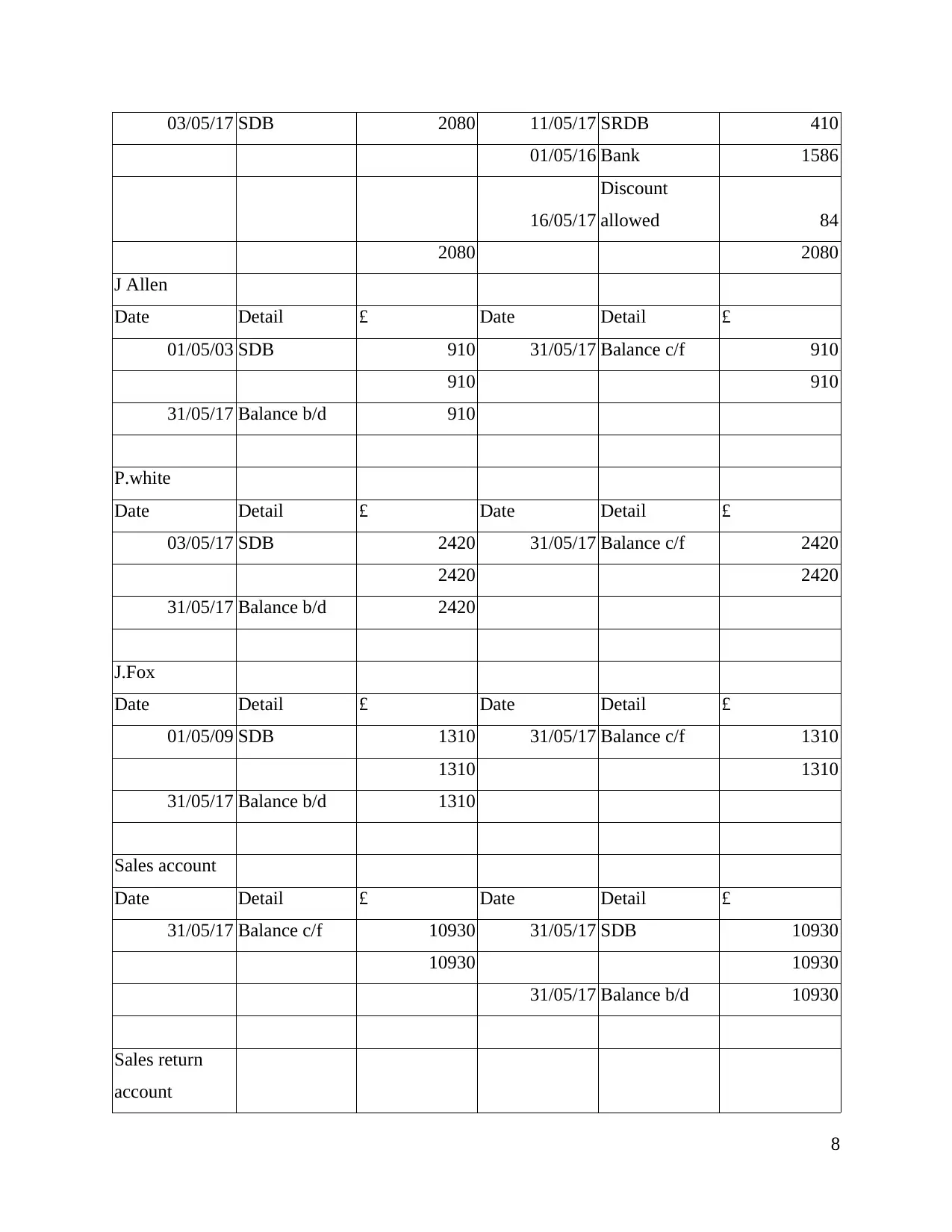
03/05/17 SDB 2080 11/05/17 SRDB 410
01/05/16 Bank 1586
16/05/17
Discount
allowed 84
2080 2080
J Allen
Date Detail £ Date Detail £
01/05/03 SDB 910 31/05/17 Balance c/f 910
910 910
31/05/17 Balance b/d 910
P.white
Date Detail £ Date Detail £
03/05/17 SDB 2420 31/05/17 Balance c/f 2420
2420 2420
31/05/17 Balance b/d 2420
J.Fox
Date Detail £ Date Detail £
01/05/09 SDB 1310 31/05/17 Balance c/f 1310
1310 1310
31/05/17 Balance b/d 1310
Sales account
Date Detail £ Date Detail £
31/05/17 Balance c/f 10930 31/05/17 SDB 10930
10930 10930
31/05/17 Balance b/d 10930
Sales return
account
8
01/05/16 Bank 1586
16/05/17
Discount
allowed 84
2080 2080
J Allen
Date Detail £ Date Detail £
01/05/03 SDB 910 31/05/17 Balance c/f 910
910 910
31/05/17 Balance b/d 910
P.white
Date Detail £ Date Detail £
03/05/17 SDB 2420 31/05/17 Balance c/f 2420
2420 2420
31/05/17 Balance b/d 2420
J.Fox
Date Detail £ Date Detail £
01/05/09 SDB 1310 31/05/17 Balance c/f 1310
1310 1310
31/05/17 Balance b/d 1310
Sales account
Date Detail £ Date Detail £
31/05/17 Balance c/f 10930 31/05/17 SDB 10930
10930 10930
31/05/17 Balance b/d 10930
Sales return
account
8
Paraphrase This Document
Need a fresh take? Get an instant paraphrase of this document with our AI Paraphraser
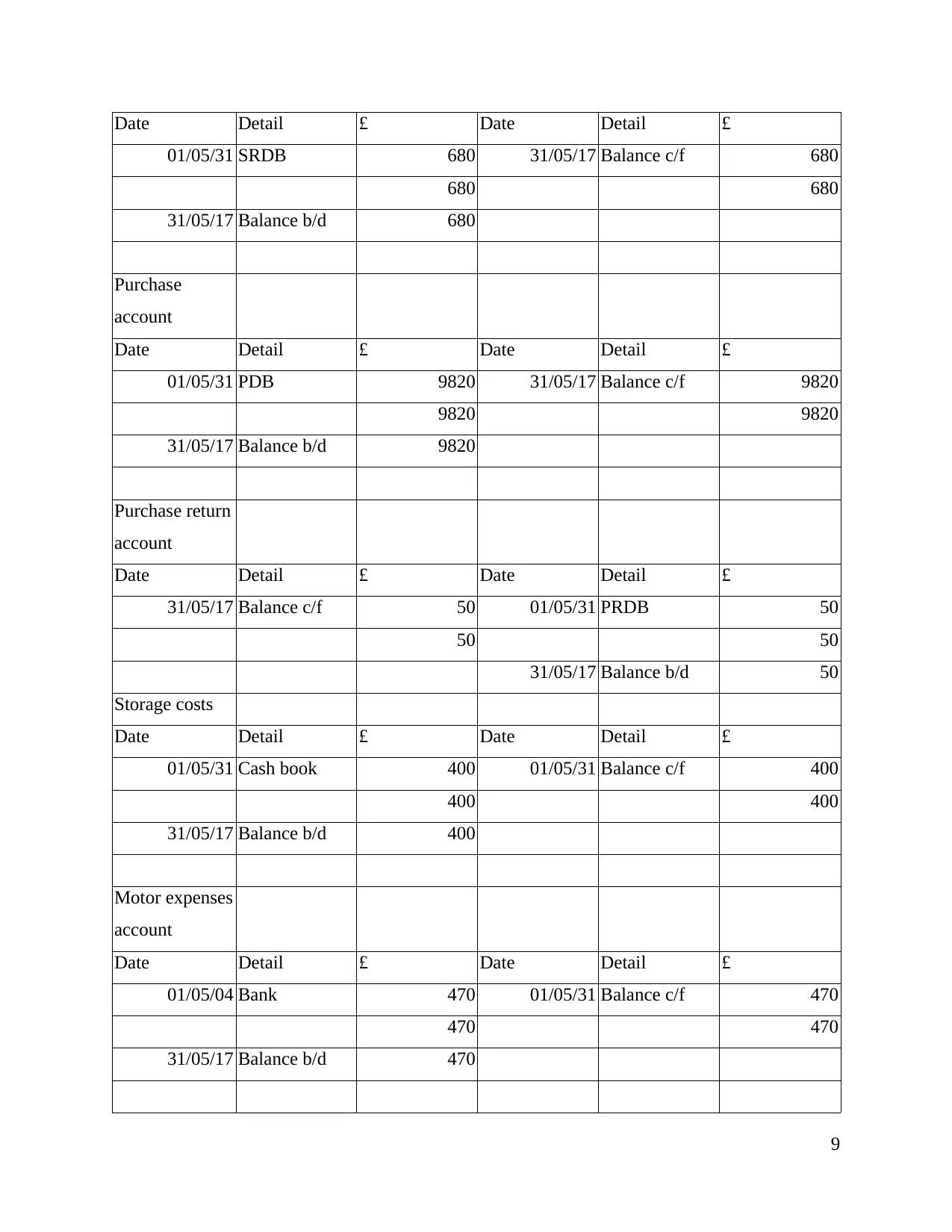
Date Detail £ Date Detail £
01/05/31 SRDB 680 31/05/17 Balance c/f 680
680 680
31/05/17 Balance b/d 680
Purchase
account
Date Detail £ Date Detail £
01/05/31 PDB 9820 31/05/17 Balance c/f 9820
9820 9820
31/05/17 Balance b/d 9820
Purchase return
account
Date Detail £ Date Detail £
31/05/17 Balance c/f 50 01/05/31 PRDB 50
50 50
31/05/17 Balance b/d 50
Storage costs
Date Detail £ Date Detail £
01/05/31 Cash book 400 01/05/31 Balance c/f 400
400 400
31/05/17 Balance b/d 400
Motor expenses
account
Date Detail £ Date Detail £
01/05/04 Bank 470 01/05/31 Balance c/f 470
470 470
31/05/17 Balance b/d 470
9
01/05/31 SRDB 680 31/05/17 Balance c/f 680
680 680
31/05/17 Balance b/d 680
Purchase
account
Date Detail £ Date Detail £
01/05/31 PDB 9820 31/05/17 Balance c/f 9820
9820 9820
31/05/17 Balance b/d 9820
Purchase return
account
Date Detail £ Date Detail £
31/05/17 Balance c/f 50 01/05/31 PRDB 50
50 50
31/05/17 Balance b/d 50
Storage costs
Date Detail £ Date Detail £
01/05/31 Cash book 400 01/05/31 Balance c/f 400
400 400
31/05/17 Balance b/d 400
Motor expenses
account
Date Detail £ Date Detail £
01/05/04 Bank 470 01/05/31 Balance c/f 470
470 470
31/05/17 Balance b/d 470
9
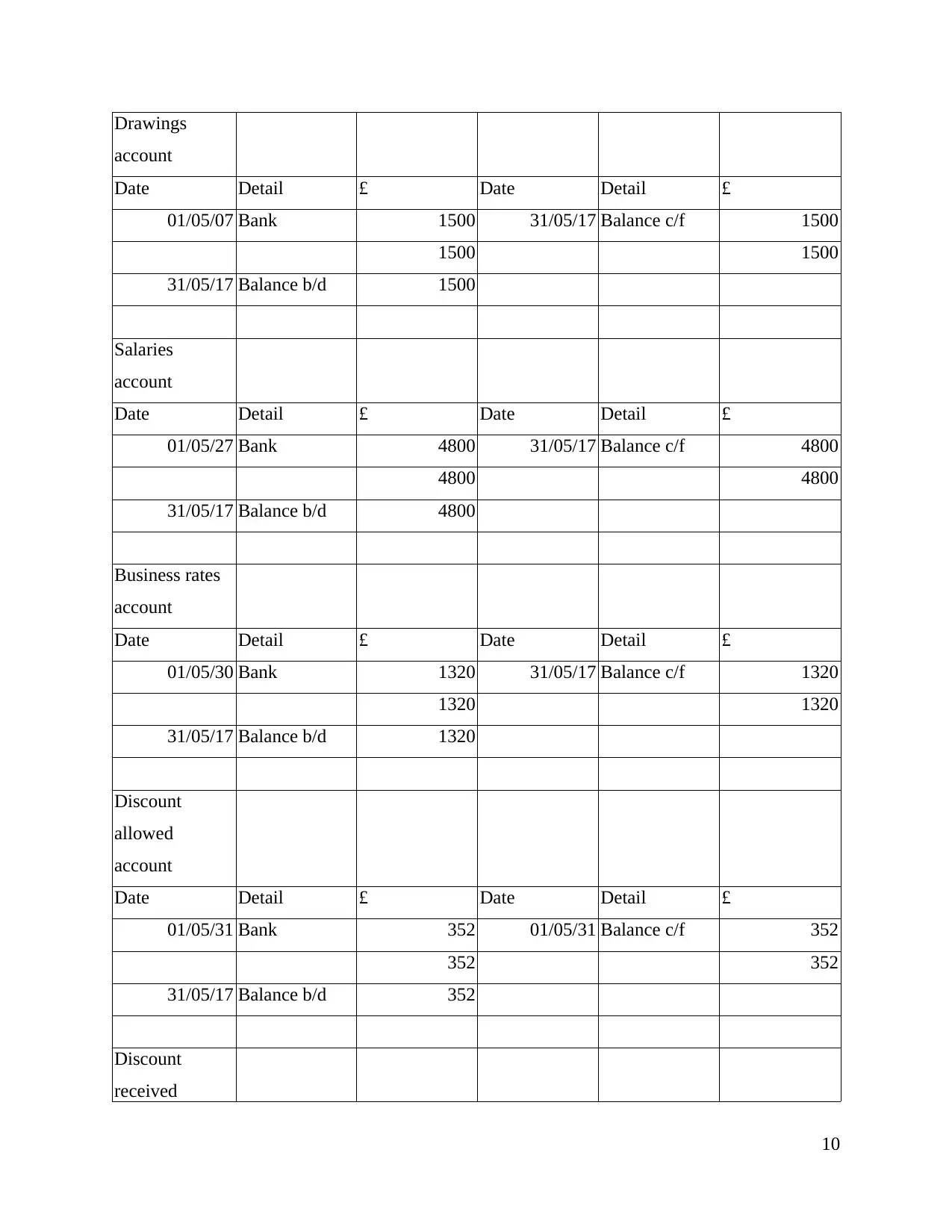
Drawings
account
Date Detail £ Date Detail £
01/05/07 Bank 1500 31/05/17 Balance c/f 1500
1500 1500
31/05/17 Balance b/d 1500
Salaries
account
Date Detail £ Date Detail £
01/05/27 Bank 4800 31/05/17 Balance c/f 4800
4800 4800
31/05/17 Balance b/d 4800
Business rates
account
Date Detail £ Date Detail £
01/05/30 Bank 1320 31/05/17 Balance c/f 1320
1320 1320
31/05/17 Balance b/d 1320
Discount
allowed
account
Date Detail £ Date Detail £
01/05/31 Bank 352 01/05/31 Balance c/f 352
352 352
31/05/17 Balance b/d 352
Discount
received
10
account
Date Detail £ Date Detail £
01/05/07 Bank 1500 31/05/17 Balance c/f 1500
1500 1500
31/05/17 Balance b/d 1500
Salaries
account
Date Detail £ Date Detail £
01/05/27 Bank 4800 31/05/17 Balance c/f 4800
4800 4800
31/05/17 Balance b/d 4800
Business rates
account
Date Detail £ Date Detail £
01/05/30 Bank 1320 31/05/17 Balance c/f 1320
1320 1320
31/05/17 Balance b/d 1320
Discount
allowed
account
Date Detail £ Date Detail £
01/05/31 Bank 352 01/05/31 Balance c/f 352
352 352
31/05/17 Balance b/d 352
Discount
received
10
⊘ This is a preview!⊘
Do you want full access?
Subscribe today to unlock all pages.

Trusted by 1+ million students worldwide
1 out of 26
Related Documents
Your All-in-One AI-Powered Toolkit for Academic Success.
+13062052269
info@desklib.com
Available 24*7 on WhatsApp / Email
![[object Object]](/_next/static/media/star-bottom.7253800d.svg)
Unlock your academic potential
Copyright © 2020–2025 A2Z Services. All Rights Reserved. Developed and managed by ZUCOL.





